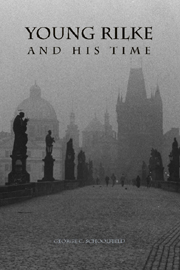Book contents
- Frontmatter
- Contents
- Preface
- Acknowledgments
- List of Abbreviations
- Chronology
- I Prague
- II Diaries
- III Rilke as Literary Critic
- IV Poems
- 8 “Der alte Invalid”
- 9 “Auswandrerschiff”
- 10 “An den Grafen von Platen”
- 11 “Die Liese wird heute just sechzehn Jahr”
- 12 “Venedig”
- 13 “Weißes Glück”
- 14 “Aus einem Bauernsommer” and “Vom Tode”
- 15 “Intérieur”
- 16 “In der Certosa”
- 17 “Die Heiligen Drei Könige”
- 18 “Aus dem hohen Jubelklanggedränge” and “Im Musiksaal”
- 19 “Karl der Zwölfte von Schweden reitet in der Ukraine”
- 20 “Sturm”
- Select Bibliography
- Index
12 - “Venedig”
from IV - Poems
Published online by Cambridge University Press: 05 February 2013
- Frontmatter
- Contents
- Preface
- Acknowledgments
- List of Abbreviations
- Chronology
- I Prague
- II Diaries
- III Rilke as Literary Critic
- IV Poems
- 8 “Der alte Invalid”
- 9 “Auswandrerschiff”
- 10 “An den Grafen von Platen”
- 11 “Die Liese wird heute just sechzehn Jahr”
- 12 “Venedig”
- 13 “Weißes Glück”
- 14 “Aus einem Bauernsommer” and “Vom Tode”
- 15 “Intérieur”
- 16 “In der Certosa”
- 17 “Die Heiligen Drei Könige”
- 18 “Aus dem hohen Jubelklanggedränge” and “Im Musiksaal”
- 19 “Karl der Zwölfte von Schweden reitet in der Ukraine”
- 20 “Sturm”
- Select Bibliography
- Index
Summary
On 26 June 1920, Rilke dredged up the memory of his first visit to Venice, in a letter to Countess Marie Therese Mirbach-Geldern, née Countess Hoyos: “Venedig will ‘geglaubt’ sein; als ich es zuerst sah, im Jahre 1897, geschahs als Gast eines Amerikaners!” (GB 4:303; Venice has to be “believed”; when I first saw it, in 1897, it was as a guest of an American!). This time he had been in Venice since 11 June, initially staying at the Hotel Europe, then, after the departure of Princess Marie von Thurn und Taxis, in her “mezzanino” in the Palazzo Valmarana. The American thus decorated with an exclamation mark was Nathan Sulzberger (1874–1954) of New York City, whom René had met after arriving in Munich from Prague. Sulzberger came from comfortable circumstances; his father, Ferdinand, was a successful meatpacker. The boy grew up bilingual; after elementary schooling in his native city he had been sent off for further education in Karlsruhe, the Sulzberger ancestral home, and was at that time a student of chemistry at Munich's university.
On 3 November 1896, René presented a copy of Larenopfer to him with a pat dedication:
Was das Herz in stillen Stunden sann,
Pocht an Andre echodurstig an.
(SW 6:1219)[What the heart in quiet hours devised,
Knocks on others, thirsting for reply.]
The next month, on the appearance of Traumgekrönt, René likewise gave it to Sulzberger; these dedicatory verses were a little on the high-and-mighty side:
… Und müssen Sie auch durch Ihr Leben
fremd aller Schöpferfreude gehn –
ist Ihnen doch die Gift gegeben,
ein frohes Schaffen zu verstehn!
(SW 3:555)- Type
- Chapter
- Information
- Young Rilke and his Time , pp. 281 - 293Publisher: Boydell & BrewerPrint publication year: 2008



